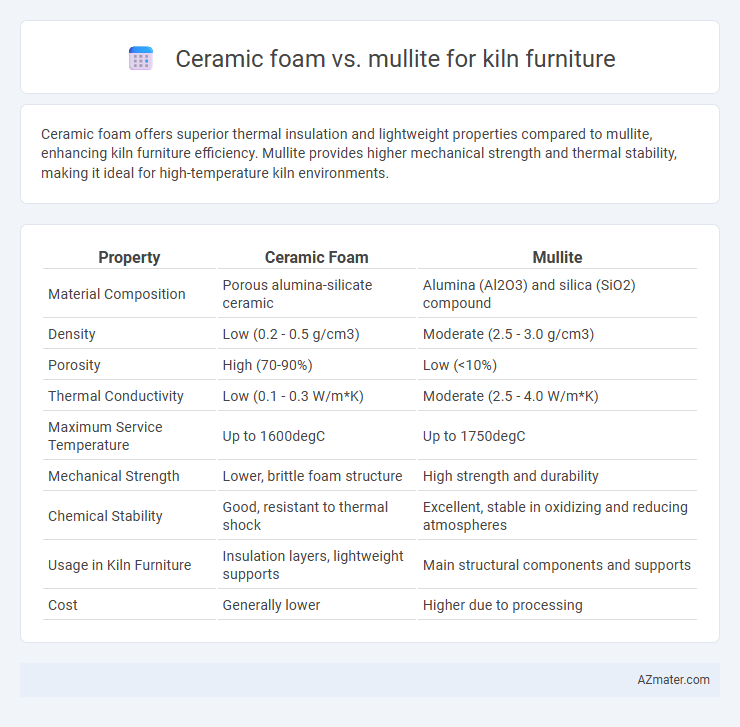Ceramic foam offers superior thermal insulation and lightweight properties compared to mullite, enhancing kiln furniture efficiency. Mullite provides higher mechanical strength and thermal stability, making it ideal for high-temperature kiln environments.
Table of Comparison
| Property | Ceramic Foam | Mullite |
|---|---|---|
| Material Composition | Porous alumina-silicate ceramic | Alumina (Al2O3) and silica (SiO2) compound |
| Density | Low (0.2 - 0.5 g/cm3) | Moderate (2.5 - 3.0 g/cm3) |
| Porosity | High (70-90%) | Low (<10%) |
| Thermal Conductivity | Low (0.1 - 0.3 W/m*K) | Moderate (2.5 - 4.0 W/m*K) |
| Maximum Service Temperature | Up to 1600degC | Up to 1750degC |
| Mechanical Strength | Lower, brittle foam structure | High strength and durability |
| Chemical Stability | Good, resistant to thermal shock | Excellent, stable in oxidizing and reducing atmospheres |
| Usage in Kiln Furniture | Insulation layers, lightweight supports | Main structural components and supports |
| Cost | Generally lower | Higher due to processing |
Introduction to Kiln Furniture Materials
Kiln furniture materials such as ceramic foam and mullite play crucial roles in high-temperature industrial processes by supporting and protecting ceramic ware during firing. Ceramic foam offers superior thermal insulation and lightweight structure due to its porous network, enhancing kiln energy efficiency. Mullite, a stable aluminosilicate ceramic, provides exceptional mechanical strength, thermal shock resistance, and chemical stability, making it ideal for prolonged exposure to elevated kiln temperatures.
What is Ceramic Foam?
Ceramic foam is a porous, lightweight material characterized by a network of interconnected pores that provide excellent thermal insulation and high surface area, making it ideal for kiln furniture applications. It offers superior resistance to thermal shock and corrosion compared to dense ceramics, enhancing durability and energy efficiency in high-temperature environments. Its unique structure allows for better gas flow and reduced heat loss, improving kiln performance during firing processes.
What is Mullite?
Mullite is a crystalline aluminum silicate mineral with exceptional thermal stability and mechanical strength, making it ideal for high-temperature applications in kiln furniture. Unlike ceramic foam, mullite offers superior resistance to thermal shock and mechanical wear, ensuring durability during repeated heating and cooling cycles. Its low thermal expansion and excellent chemical stability enhance kiln performance by maintaining structural integrity under extreme firing conditions.
Physical and Thermal Properties Comparison
Ceramic foam offers superior thermal insulation with low thermal conductivity around 0.05-0.1 W/m*K compared to mullite's 3-5 W/m*K, enhancing energy efficiency in kiln operations. Mullite exhibits greater mechanical strength and high-temperature resistance up to 1700degC, while ceramic foam typically withstands temperatures near 1400degC but excels in shock absorption due to its porous structure. The density of mullite ranges between 3.0-3.2 g/cm3, significantly higher than ceramic foam's 0.3-0.7 g/cm3, making mullite preferred for load-bearing kiln furniture and ceramic foam ideal for insulating components.
Strength and Durability in High-Temperature Conditions
Ceramic foam demonstrates superior thermal shock resistance and lightweight insulation, making it ideal for kiln furniture exposed to rapid temperature changes, while mullite offers exceptional mechanical strength and dimensional stability at temperatures exceeding 1600degC. Mullite's inherent high melting point and resistance to chemical corrosion ensure prolonged durability under continuous high-heat firing cycles compared to ceramic foam. Selecting mullite kiln furniture optimizes longevity in industrial kilns due to its robust structural integrity and resistance to deformation under extreme thermal stress.
Thermal Shock Resistance: Ceramic Foam vs Mullite
Ceramic foam exhibits superior thermal shock resistance compared to mullite, due to its porous structure which effectively dissipates thermal stress. Mullite, although valued for its high-temperature stability and mechanical strength, has lower resistance to rapid temperature changes leading to potential cracking. This makes ceramic foam more suitable for kiln furniture applications involving frequent thermal cycling and rapid heating and cooling.
Weight and Design Flexibility
Ceramic foam kiln furniture offers significant weight reduction compared to mullite, enhancing thermal efficiency and ease of handling during kiln operations. Mullite, while heavier, provides superior structural integrity but limits design flexibility due to its denser composition and manufacturing constraints. The porous nature of ceramic foam allows for intricate shapes and custom configurations, making it ideal for complex kiln designs requiring lightweight support structures.
Energy Efficiency and Firing Performance
Ceramic foam offers superior thermal insulation and reduced heat transfer compared to mullite, significantly enhancing energy efficiency during kiln firing by lowering fuel consumption. Mullite provides excellent mechanical strength and thermal stability at high temperatures, ensuring durable kiln furniture that withstands repeated thermal cycling without deformation. The porous structure of ceramic foam promotes uniform heat distribution, improving firing performance and product quality while minimizing energy loss.
Cost Analysis and Long-Term Value
Ceramic foam kiln furniture offers a lower initial cost due to its lightweight structure and reduced material consumption, while mullite provides superior durability and thermal stability, leading to extended service life and less frequent replacement. The higher upfront investment in mullite kiln furniture often results in better long-term value through enhanced resistance to thermal shock and chemical corrosion, minimizing downtime and maintenance expenses. Cost analysis favors ceramic foam for short-term or low-budget projects, whereas mullite is more cost-effective for high-temperature, long-cycle industrial applications requiring robust performance.
Choosing the Right Material for Your Kiln Furniture
Ceramic foam offers superior thermal insulation and lightweight properties, making it ideal for energy-efficient kilns, while mullite provides exceptional high-temperature strength and thermal stability essential for heavy-duty kiln furniture applications. Selecting the right material depends on the firing temperature, mechanical load, and desired kiln atmosphere; ceramic foam excels in reducing heat loss, whereas mullite withstands extreme thermal shock and mechanical stress. Evaluating specific kiln requirements ensures optimal performance, longevity, and cost-effectiveness in kiln furniture design.

Infographic: Ceramic foam vs Mullite for Kiln furniture
 azmater.com
azmater.com